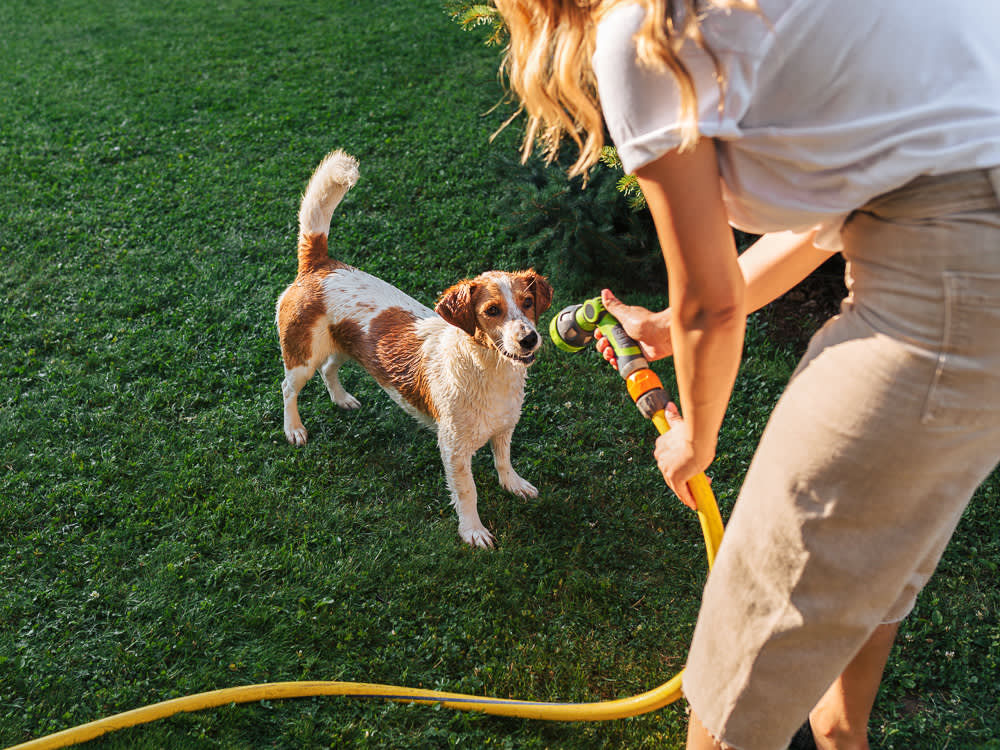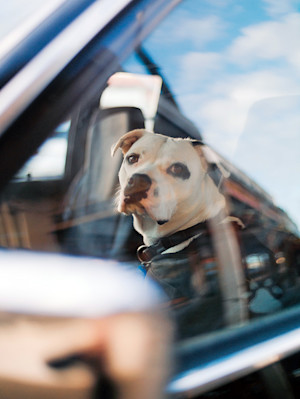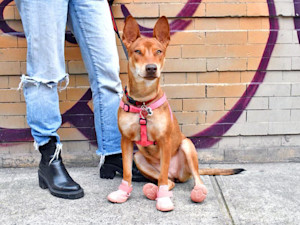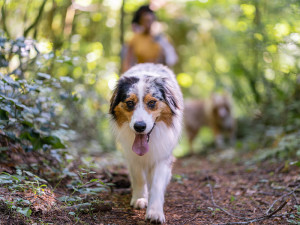How to Keep Your Dog Safe From Heatstroke This Summer
Temperatures are rising dangerously. Keep your pet safe with these tips.
The sun is in the sky and all those summertime activities are calling your name — sounds like the perfect time to get some rays in with your dog after a long winter indoors, right? Well, yes and no. When it comes to time in the warm weather with your dog, there are some important caveats to keep in mind. This is the season when heatstroke poses a major risk to animals.
Just this past month, a dog in Houston died after being left on an apartment balconyopens in new tab in the heat. Another dog passed this week after being left in a hot car.opens in new tab And due to an apparent air conditioning malfunction, Maine’s first comfort dog diedopens in new tab in a state vehicle. These horrific stories are sobering reminders that dogs can quickly fall fatally ill from heatstroke — sometimes from outright neglect, and other times from a lack of awareness. That’s why learning everything you need to know about heatstroke is a crucial step toward protecting your dog.
Snap a pic of your pup’s teeth, and GREENIES™ will help you spot potential signs of oral health issues.
What is heatstroke in dogs?
Heatstroke in dogs, also known as hyperthermia, is a life-threatening emergency that occurs when a dog’s body temperature rises to dangerous levels, typically over 105 degrees Fahrenheit. The normal body temperature of a dog is 101.5 degrees Fahrenheit, plus or minus one. The typical culprits of this condition are excessive activity in hot weather, high temperatures, or confinement in a hot and poorly ventilated car, but heat stroke can occur even in mild temperatures. Heat-related illnesses come in three stages, each leading to the next if left untreated. The three stages are:
Heat stress: Heat stress is a precursor to the more severe illnesses. With heat stress, dogs may have increased panting and thirst, but they can generally walk and behave normally.
Heat exhaustion: Heat exhaustion, a milder form of heatstroke, occurs if a dog’s body temperature rises above 103 degrees Fahrenheit. Symptoms of heat exhaustion include fatigue, thirst, weakness, and potential collapse. Untreated heat exhaustion results in heatstroke.
Heatstroke: If your dog is experiencing this serious condition, it’s crucial to seek medical attention immediately. If left untreated, prolonged exposure to high temperatures and heat exhaustion can result in organ failure, and potentially lead to death.
Many people are unaware of how dogs process heat and how easily dogs can succumb to heatstroke. Dogs cannot tolerate high temperatures as well as humans because they depend upon rapid breathing (panting) to exchange their warm body air for cooler environmental air. When the air temperature is close to body temperature, cooling by rapid breathing is no longer an efficient process, and dogs can succumb to heatstroke in a relatively short time.
How much do you spend on your pet per year?
Common causes of heatstroke
There are a few top culprits for heatstroke in dogs.
Leaving a dog in the car with “the windows cracked”
Even in mild temperatures, it isn’t safe to leave dogs in a car — full stop. On a relatively cool 75-degree day, the temperature inside a car can increase an average of 40 degrees Fahrenheit within one hour. That means it can reach temperatures of 115 degrees Fahrenheit in the car, whether the windows are cracked or not.
Leaving an animal in any enclosed space where this is no cooling system
Cars aren’t the only space where dogs can overheat. It’s possible for a dog enclosed inside a home or other space without AC to suffer from heatstroke. If the weather is especially hot, do not leave your dog unattended in a space for long.
If the AC or fans goes out, and you are not home, your dog could easily overheat in extreme temperatures. If you can’t come home often to check on your pups in this case, have someone go over to do so for you.
When an animal is left outdoors or exercised in hot or humid weather
You might be surprised how many pets have developed heatstroke while out for a routine walk. Short legs are one risk factor; pups with short legs are closer to the pavement, with radiates heat, contributing to the development of heat exhaustion or stroke. When outdoors, dogs should always be provided with adequate shade.
Other factors that increase the risk of heatstroke
Risk factors that make dogs more susceptible to heatstroke include age (puppies and seniors are at higher risk), obesity, existing breathing or heart conditions, and brachycephaly. Brachycephalic breeds are short-nosed, flat-faced dogs, such as Pugs, Lhasa Apsos, Pekingese, Boston Terriers, or Bulldogs. These dogs suffer from ineffectual panter syndrome, which basically means that their elongated palate in a short face interferes with their ability to pant, and that can be fatal.
Signs of heatstroke in dogs
Initially, the main symptom of heatstroke in dogs is excessive panting. Dogs suffering from heatstroke will appear distressed and become restless. As the heatstroke progresses, the dog may drool large amounts of saliva from the nose and/or mouth and may even become unsteady on their feet. You may notice their gums turning bright red or blue/purple, which is caused by inadequate oxygen.
Other signs include:
Distressed and restless behavior
Excessive drooling
Blue/purple or bright red gums
Brightened tongue
Rapid breathing
Increased heart rate
Glazed eyes
Lethargy
Weakness
Collapse
How to treat heatstroke in dogs
Severe heatstroke is a disease that affects nearly every system in the dog’s body. Simply lowering the body temperature fails to address the potentially catastrophic events often accompanying this disorder. A dog suffering from heatstroke should be seen by a veterinarian as soon as possible for appropriate care. Here’s what you should do if you suspect your dog has heatstroke:
Immediately, move your dog to a shaded and cool environment.
If possible, determine the rectal temperature and record it.
Begin to cool the body by placing wet towels (use cool tap water) over the dog’s back of the neck, armpits, and groin region. Refresh often.
Wet the dog’s ear flaps and paws with cool water.
Direct a fan to the wet areas to speed up evaporative cooling.
Transport your pup to the closest available veterinary clinic immediately.
Most dogs with heatstroke have body temperatures greater than 105 degrees Fahrenheit, and a reasonable goal of cooling is to reduce your pet’s body temperature to between 102.5 degrees Fahrenheit and 103 degrees Fahrenheit while transporting them to the closest veterinary facility.
Once your pup arrives at the vet, they can provide better supportive treatment for heatstroke and the associated complications. Your veterinarian will aim to increase blood volume and enhance blood circulation, balance electrolytes, and may administer antibiotics to prevent complications from infections and sepsis. If your pup has a thick undercoat, it may be shaved to help increase cooling. Your vet will likely provide your dog with oxygen therapy at the time of admittance, but in more severe cases, general anesthesia with 100 percent oxygen may be required.
What not to do during a heatstroke
Avoid using ice. Rapidly cooling off the dog is extremely important, but do not use cold water or ice for cooling! While using ice or cold water may seem like a logical step, it isn’t the best course of action. Ice or cold water will cause superficial blood vessels to shrink (vasoconstriction), effectively forming an insulating layer of tissue to hold the heat inside. This causes the cooling of the body’s innermost structures to actually be delayed — the opposite effect that you want. Tap water is more suitable for effective cooling.
Avoid forcing water. Keep an eye on your pet and do not leave them unattended for any length of time. Do not attempt to force water into your dog’s mouth, but you may have fresh cool water ready to offer should your dog be alert and show an interest in drinking.
How can I prevent heatstroke in my dog?
There are a number of things you can do to prevent heatstroke in your dog.
Make sure your dog has access to plenty of fresh, cool water at all times.
Avoid exercising your dog on hot days.
Avoid strenuous exercise during the hottest part of the day, between 11am and 5pm.
Never leave your dog in a parked car, even in mild weather or “just” for a few minutes.
Make sure your dog has a shady spot to rest in.
Cool off your pup with a damp cloth.
Plan to give your pup plenty of breaks.
Don’t leave your dog alone in a garage or other enclosed area.
Avoid walking on sand, concrete or other hot surfaces which may reflect heat.
What are the potential complications of heatstroke in dogs?
Heatstroke is very damaging to the body, so the prognosis is poor. Over 40 percentopens in new tab of dogs die following an episode of heatstroke, often due to multi-organ failure (MOD) or abnormal bleeding and excessive clotting (disseminated intravascular coagulation).
Most deaths occur within 24 hours, and survival past 48 hours usually results in a good prognosis. Some dogs suffer from long-term effects such as permanent organ damage requiring life-long care. But immediate treatment will give your dog the best chance for survival. Some of the complications of heatstroke include:
Organ failure
Abnormal bleeding
Excessive blood clotting
Neurological (brain) damage
Heart arrhythmias
Secondary infections
What if I see a pet in distress?
Some states prohibit leaving dogs unattended in vehicles, but it is still a common sight. Since each state and local governments have different laws, if you do happen to see a pet in distress, you can call the local animal control agency, police, or 911 for assistance. Any police officer, humane officer, or animal control officer is authorized to take all steps necessary to remove an animal from an unattended car.
FAQs
Are there any first aid measures I can take for a dog with heatstroke?
Dogs with heatstroke should be immediately taken to the vet. While in transit, utilize first aid measures to help cool your dog: apply wet, cool towels on the dog’s back of the neck, armpits, and groin region, then use a fan to help evaporate the heat.
How does heatstroke occur in dogs?
Heatstroke is a devastating condition that occurs when a dog overheats and cannot cool off on their own. Unlike humans, dogs cool themselves by panting, which makes them much more susceptible to heat-related illnesses.
What are the potential complications of heatstroke in dogs?
Potential complications for heatstroke in dogs include seizures, organ failure, blood clots, excessive bleeding, brain damage, heart problems, infections, and even death.
How can I prevent heatstroke in my dog?
You can prevent heatstroke in your dog by providing ample access to fresh cool water, providing them plenty of shade, avoiding exercising in the heat, and never leaving your dog unattended in a car.
What should I do if I suspect my dog has heatstroke?
If you suspect your dog has heatstroke, you should apply cool, wet towels on your dog’s neck, armpits, and groin area, then rush to the veterinarian immediately. Early treatment can significantly improve your pup’s chances for recovery.
When should I seek veterinary help for a dog with heatstroke?
You should seek veterinary help immediately if you suspect your dog has heatstroke. The sooner they receive care, the better their prognosis. Call ahead to ensure your vet is available or take them to an emergency vet.
Can heatstroke be fatal for dogs?
Yes, heatstroke in dogs can be fatal. If you suspect your dog is suffering from this life-threatening condition, you should take your dog to the vet ASAP.
References
A Novel Severity Scoring System for Dogs with Heatstrokeopens in new tab
Heatstroke in Dogs: Clinical Signs, Treatment, Prognosis, and Prevention*opens in new tab
Pathophysiology and Pathological Findings of Heatstroke in Dogsopens in new tab
Pathophysiology of Heatstroke in Dogs – Revisitedopens in new tab
Pathological Findings in Dogs with Fatal Heatstrokeopens in new tab
Today’s Veterinary Practice - Heatstroke in Dogsopens in new tab
Treatment of Hyperthermia and Heat-Induced Illnessopens in new tab










